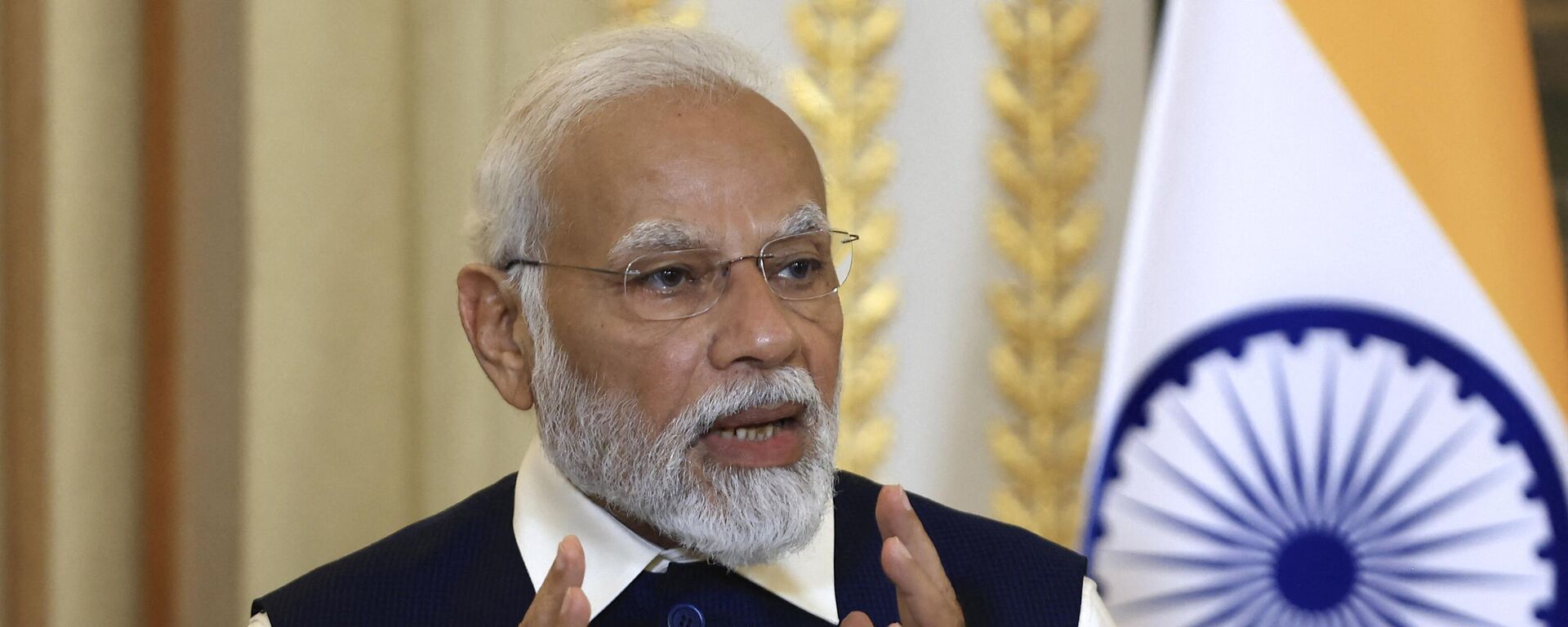https://sputniknews.in/20240112/de-dollarisation-in-progress-india-works-to-replace-dollar-with-inr-6172568.html
De-dollarisation in Progress: India Works to Replace Dollar with INR
De-dollarisation in Progress: India Works to Replace Dollar with INR
Sputnik India
Prime Minister Narendra Modi while inaugurating the 10th edition of Vibrant Gujarat Global Summit said that India will be among three largest economies in the world in coming few years. Sputnik India reached out to Dr S P Sharma, Chief Economist and Deputy Secretary General of PHDCCI, to talk about India’s growth.
2024-01-12T15:48+0530
2024-01-12T15:48+0530
2024-01-12T15:48+0530
sputnik opinion
india
new delhi
delhi
barter trade
trade corridor
rupee-rouble trade
trade barriers
trade in national currencies
dedollarisation
https://cdn1.img.sputniknews.in/img/07e8/01/0c/6177931_0:0:3072:1728_1920x0_80_0_0_995fc707f91a011e45231183704ef30d.jpg
The report titled "New Year Economics PHDCCI Economic Outlook 2024" released by the PHD Chamber of Commerce and Industry projects that India will be the most resilient economy among the top 10 leading economies in 2024 and 2025.The projection is based on the leading macroeconomic indicators, including the GDP growth, export growth, gross national savings, total investments, and debt-to-GDP ratio.The report also stated that the Indian economy is expanding by more than £4 trillion in 2024 and identified the following fields as promising sectors for growth.However, it also cited the deepening geopolitical developments, fragmentation in the commodity markets, and inflationary pressures as the downside risks to the Indian economy.While speaking to Sputnik India, Dr S.P. Sharma, Chief Economist and Deputy Secretary General of PHDCCI, discussed various factors behind the growth of the Indian economy, the impact of geopolitical spillovers, and the benefits of trading in local currencies.Discussing the reasons behind the steep growth of the Indian economy, Sharma stated that the major pillars of the Indian economy are hardworking people, zeal of our businesses, and support from the government.He highlighted that in order to bring the reforms at ground level, the government removed around 40,000 compliances from the tedious processes during the last 2-3 years, which has increased the confidence of the businesses and therefore they are expanding.Indian Main ChallengeDespite being the fastest-growing economy for the third consecutive year, India’s main challenge is to control food inflation.Sharing his views on inflation, the PHDCCI Deputy Secretary General said that it is a major challenge, but this can be tackled by increasing the capacity of the cold storages in the country.He added that it would be a great support to supply chains and would have an impact on food prices.Touching upon the diplomatic issues with countries like Canada and Maldives and their impact, the economic expert opined that such rows won't have an impact on the Indian economy."The main reason is that India is the growth leader and countries need us. The government is focusing on self-reliance and India can grow by more than 7 per cent without any support. In time to come, India will become a manufacturing hub which means the other countries need us," Sharma said.When asked whether trade in local currencies will help the Indian economy to grow amid geopolitical spillovers, Sharma said that it will significantly boost the economy.He, however, said trade in local currencies is in the initial stage but will become effective in time to come. "As far as trade in local currencies is concerned, we are reforming and have already allowed rupee transactions with many countries. I think more than 17-18 countries are allowed to transact in rupee," the PHDCCI Deputy Secretary General said.He opined that India is in the process of replacing dollar with the rupee with many economies so that there is no pressure on the Indian currency.
https://sputniknews.in/20240110/india-to-be-among-top-three-global-economies-in-near-future-modi-6152324.html
india
new delhi
delhi
gujarat
canada
maldives
Sputnik India
feedback.hindi@sputniknews.com
+74956456601
MIA „Rossiya Segodnya“
2024
Rahul Trivedi
https://cdn1.img.sputniknews.in/img/07e6/0c/13/136500_0:0:628:627_100x100_80_0_0_72097ff894c7446b70d2efafcb719720.jpg
Rahul Trivedi
https://cdn1.img.sputniknews.in/img/07e6/0c/13/136500_0:0:628:627_100x100_80_0_0_72097ff894c7446b70d2efafcb719720.jpg
News
en_IN
Sputnik India
feedback.hindi@sputniknews.com
+74956456601
MIA „Rossiya Segodnya“
Sputnik India
feedback.hindi@sputniknews.com
+74956456601
MIA „Rossiya Segodnya“
Rahul Trivedi
https://cdn1.img.sputniknews.in/img/07e6/0c/13/136500_0:0:628:627_100x100_80_0_0_72097ff894c7446b70d2efafcb719720.jpg
new year economics phdcci economic outlook 2024, phd chamber of commerce and industry, india among top 5 global economy, india is fastest-growing economy, top 10 leading economies of the world, gdp growth, export growth, gross national savings, geopolitical developments, fragmentation in the commodity markets, inflationary pressures, downside risk to indian economy, trade in local currencies
new year economics phdcci economic outlook 2024, phd chamber of commerce and industry, india among top 5 global economy, india is fastest-growing economy, top 10 leading economies of the world, gdp growth, export growth, gross national savings, geopolitical developments, fragmentation in the commodity markets, inflationary pressures, downside risk to indian economy, trade in local currencies
De-dollarisation in Progress: India Works to Replace Dollar with INR
India will be among the three largest economies in the world in the coming few years, according to Prime Minister Narendra Modi. Sputnik India approached an expert to discuss India's growth.
The report titled "New Year Economics PHDCCI Economic Outlook 2024" released by the PHD Chamber of Commerce and Industry projects that India will be the most resilient economy among the top 10 leading economies in 2024 and 2025.
The projection is based on the leading macroeconomic indicators, including the GDP growth, export growth, gross national savings, total investments, and debt-to-GDP ratio.
The report also stated that the Indian economy is expanding by more than £4 trillion in 2024 and identified the following fields as promising sectors for growth.
agriculture and food processing,
electronics, and fintech .
However, it also cited the deepening geopolitical developments, fragmentation in the commodity markets, and inflationary pressures as the downside risks to the
Indian economy.
While speaking to Sputnik India, Dr S.P. Sharma, Chief Economist and Deputy Secretary General of PHDCCI, discussed various factors behind the growth of the Indian economy, the impact of geopolitical spillovers, and the benefits of trading in local currencies.
Discussing the reasons behind the steep growth of the Indian economy, Sharma stated that the major pillars of the Indian economy are hardworking people, zeal of our businesses, and support from the government.
"The government's support has been extremely important and the efforts are visible. We have seen that India has improved in the ease of doing business index. However, these were the macro numbers, but the government felt that the reforms that have been introduced need to trickle down to the ground level," he said.
He highlighted that in order to bring the reforms at ground level, the government removed around 40,000 compliances from the tedious processes during the last 2-3 years, which has increased the confidence of the businesses and therefore they are expanding.
“This is the reason the Indian economy has been growing more than 7 percent in the post-pandemic years. It grew by 9.1 percent in FY21-22, then by 7.2 in FY22-23, and now we are moving ahead with 7.3 or 7.4 percent in FY23-24,” the chief economist said.
Despite being the fastest-growing economy for the third consecutive year, India’s main challenge is to control food inflation.
Sharing his views on inflation, the PHDCCI Deputy Secretary General said that it is a major challenge, but this can be tackled by increasing the capacity of the cold storages in the country.
"According to reports, more than 30-35 per cent of our agricultural production is wasted. So this figure should be reduced to less than 10 per cent, if not zero. Therefore, the cold storage capacity should be increased so that the wastage can be reduced," he said.
He added that it would be a great support to supply chains and would have an impact on food prices.
Touching upon the
diplomatic issues with countries like Canada and Maldives and their impact, the economic expert opined that such rows won't have an impact on the Indian economy.
"The main reason is that India is the growth leader and countries need us. The government is focusing on self-reliance and India can grow by more than 7 per cent without any support. In time to come, India will become a manufacturing hub which means the other countries need us," Sharma said.
When asked whether trade in local currencies will help the Indian economy to grow amid geopolitical spillovers, Sharma said that it will significantly boost the economy.
"India recorded a trade of $770 billion in FY21-22 and this number will be higher compared to last year. However, there has been some impact on the trade scenario due to the disruption in the supply chains at the global level. Despite this, we are rejuvenating and connecting with the international supply chains so that the trade will grow in the coming time," he said.
He, however, said
trade in local currencies is in the initial stage but will become effective in time to come. "As far as trade in local currencies is concerned, we are reforming and have already allowed rupee transactions with many countries. I think more than 17-18 countries are allowed to transact in rupee," the PHDCCI Deputy Secretary General said.
He opined that India is in the process of replacing dollar with the rupee with many economies so that there is no pressure on the Indian currency.



